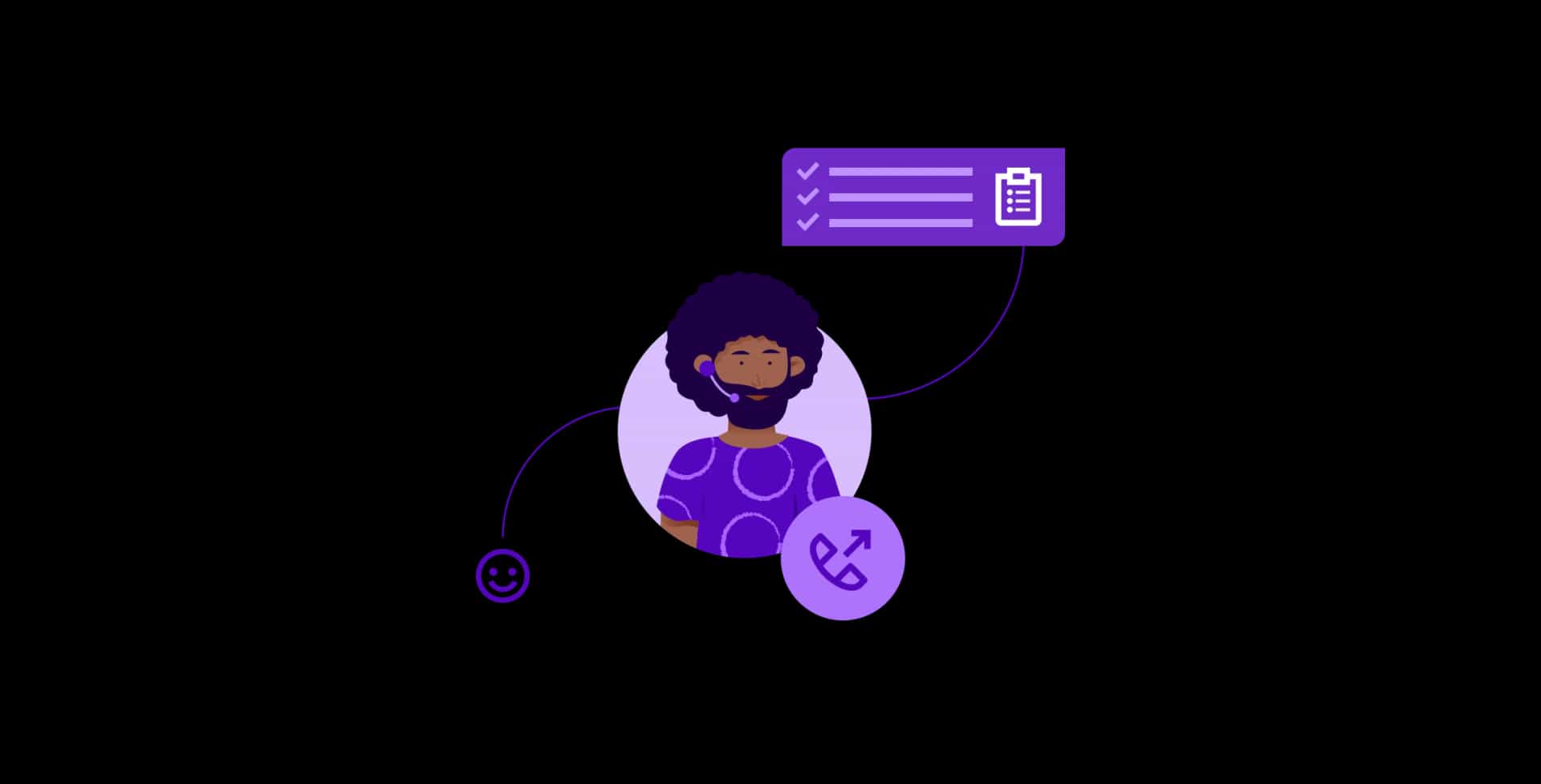What is an outbound contact center?

By Celia Cerdeira
0 min read

Every interaction is an opportunity.
That’s why outbound contact centers are so powerful for businesses. By choosing to proactively reach out to customers, companies can drive sales, enrich market research, and ultimately strengthen customer relationships.
Running an outbound contact center has several requirements, such as recruiting and training skilled agents, carefully managing contact lists, and continuously analyzinge performance.
Here’s the good news: AI-enabled software for outbound contact centers makes these processes easier—and more effective.
Whether a company is looking to optimize agent workflows, simplify the agent-customer communication process, or take its telemarketing game to the next level, an AI outbound contact center solution can help agents quickly fulfill their duties without losing that personal touch, increasing customer loyalty and, potentially, revenue growth.
Read on to learn about the basics and benefits of outbound contact centers and why more companies are looking for solutions that leverage AI.
What is an outbound contact center, and how does it work?
An outbound contact center is a business function where agents reach out to current or potential customers. Instead of waiting for customers to make the first move, agents take on a more proactive role, contacting prospective clients, collecting feedback, following up with current customers, sharing offers, or raising funds.
Outbound contact centers can help improve customer service, marketing efforts, revenue, customer satisfaction, and retention rates. By initiating contact, companies can proactively provide customers with the best possible experience.
Outbound contact center vs outbound call center: what’s the difference?
Both outbound contact centers and outbound call centers have agents who proactively contact customers. The difference between the two outreach models is the channels agents use to contact customers.
Outbound call centers focus on reaching out to customers over the phone. This traditional approach relies heavily on voice communication, where agents make cold calls, follow-up calls, or conduct surveys.
Outbound contact centers are the modern-day version of call centers. Instead of simply calling customers, outbound contact centers reach them across the channels they prefer. They might call them, but they can also initiate contact through social media messaging, live chats, email, and text.
How is an outbound contact center different from an inbound contact center?
Both inbound and outbound contact centers use multiple channels to engage with customers. However, while outbound contact centers are responsible for proactively initiating contact with customers on behalf of a company, inbound contact centers handle incoming communications.
As a result, inbound contact centers are better suited for handling technical support requests and incoming customer inquiries. Meanwhile, outbound contact centers are necessary for tasks like telemarketing, appointment reminders, market research, lead generation, and customer satisfaction surveys.
What benefits does an AI outbound contact center provide?
Outbound contact center software—especially software that leverages AI—can help maximize outreach efforts while maintaining high customer satisfaction.
Improve agent productivity by 200-300% with generative AI.
An AI-enabled outbound contact center solution can dramatically improve agent productivity. Some tools can filter out voicemail, no answers, and busy signals, enabling users to double and even triple the number of outbound calls per hour while driving up contact rates.
Organizations can also deploy generative AI, including tools like ChatGPT, across their contact centers to automate repetitive tasks. Generative AI can automatically summarize customer interactions, reducing after-contact work time.
Other use cases of generative AI in an outbound contact center environment include:
-
Sentiment analysis: Generative AI can analyze customer interactions, picking up on customers’ emotions and attitudes as well as any ambiguities.
-
Virtual agents: Organizations can also use a generative AI-based virtual agent to handle outbound contact center operations like administering surveys, texting potential customers, and executing telemarketing strategies. Thanks to generative AI, these outbound contact center solutions can easily understand and participate in conversations.
-
Agent training materials: Generative AI can also create comprehensive, personalized training materials and simulations for agents, helping them improve their skills and adapt to different customer scenarios. This continuous learning approach ensures agents are always at their best.
-
Knowledge bases: Generative AI can also power knowledge bases, allowing agents to quickly access accurate information during interactions with customers. As a result, agents will be armed with all the relevant information they need to make the most of their customer interactions.
Proactively engage customers with automated notifications.
Outbound contact center software offers automated, proactive notifications, allowing companies to engage with customers with minimal effort while reaping a high return on investment.
For example, setting up automatic notifications to remind customers of upcoming appointments shows the organization understands each customer’s needs and individual situation and reduces the need for customers to reach out to agents.
Integrate with CRM customer lists.
Outbound contact centers must keep track of their customer lists when executing their contact strategy. This involves carefully managing leads and respecting do not contact requests and other guidelines.
As a manual process, this requires a lot of time and effort. Organizations must update qualifying leads, add new contact details, remove outdated ones, and more. In short, it’s a significant time commitment. That’s why having outbound contact center software that integrates with CRM systems is a must.
CRM integration seamlessly connects a CRM and a contact center. For example, an organization could upload a CSV file with its most up-to-date calling list or automatically pull records from Salesforce using an API.
This seamless integration allows agents to work from the most updated customer lists, while customer files are automatically updated after interactions. Agents can be more productive and access the information they need to personalize conversations.
Which metrics matter for outbound contact centers?
Organizations must track specific key performance indicators (KPIs) to ensure their outbound contact centers run efficiently.
For an outbound contact center solution, organizations should measure:
-
Agent status: Knowing when agents list themselves as available, offline, away, interacting with a customer, or completing after-contact work can give valuable insights into a team’s overall productivity. Organizations can then optimize workflows and redistribute or reschedule agents as necessary.
-
Contact rate: The contact rate, or the percentage of successful connections made out of the total number of contact attempts, can shed some light on the efficiency of outbound campaigns and the quality of the lead list. If the contact rate is low, an organization may want to revisit its contact lists or reevaluate its strategy.
-
First contact resolution: The first contact resolution represents the percentage of outreach attempts that were successful on the first try. It can be found by dividing the number of successful conversions on the first attempt by the total number of outbound contact attempts and multiplying by 100. Higher first contact resolution rates signify efficient agents. On the other hand, lower rates may indicate that an organization needs to update its agents’ scripts, level up agent training, or even change its product or service.
-
Conversion rate: It’s also a good idea to track the overall conversion rate. This metric measures the percentage of successful outbound contact attempts and can give similar insights to the first contact close rate. Lower conversion rates result in a higher cost per lead, so investing in improving conversion rate can pay off.
-
Average handle time: Find the average handle time (AHT) by adding the total talk time, hold time, and after-contact work time (reviewing customer history, entering data, etc.) and dividing that by the total number of outbound contacts. This metric measures the average amount of time agents spend handling customer interactions, from the moment the interaction begins to the second the after-work activities end. Shorter AHTs would give agents more time to complete additional outbound outreach, potentially raising conversions and revenue.
-
Occupancy rate: Find agents’ occupancy rate by dividing the total handle time by the total logged-in time and multiplying by 100. This metric compares the amount of time an agent spends contacting customers or performing after-contact-related work to the total time they are available.
-
Contacts per agent: Organizations can better understand each agent’s performance by tracking the number of contact attempts agents make over a certain period. They can then revamp their schedule and staffing levels as needed.
-
After-contact work: After-contact work, or wrap-up time, is the amount of time agents spend completing tasks after finishing customer interactions. This includes taking notes, updating files, entering data, scheduling follow-up messaging, and escalating situations to supervisors. Automation features can significantly reduce the amount of after-contact work required.
These are by no means all the KPIs organizations should consider tracking, but they’re a good start. By taking the time to collect and analyze these metrics, organizations can gain a better understanding of agents, their productivity levels, and overall efficiency. They’ll know what’s working, where there’s room for improvement, and how to take action to bring operations to the next level.
Embracing the AI-driven future of outbound contact centers.
An AI-driven outbound contact center is the key to staying ahead in the competitive landscape and delivering exceptional customer experiences.
By integrating advanced AI technologies, companies can streamline agent workflows, improve productivity, and maintain a personal touch in customer interactions. These solutions not only automate repetitive tasks and optimize outreach strategies but also provide valuable insights through performance metrics.
As a result, businesses can drive higher conversion rates, improve customer satisfaction, and achieve greater operational efficiency. Embracing AI in outbound contact centers is a strategic move that can lead to sustained growth and a competitive edge.
Ready to take your outbound contact center to the next level? Discover how Talkdesk Proactive Outbound Engagement™ can help.





